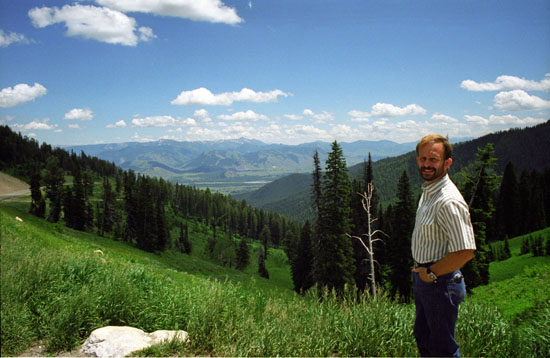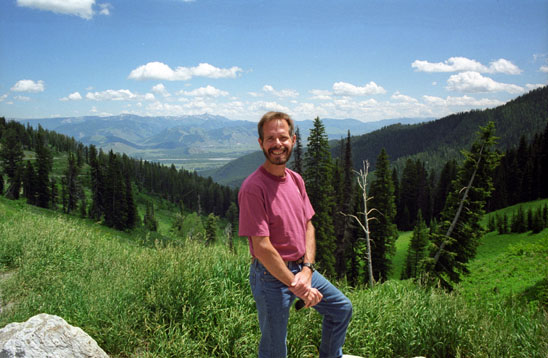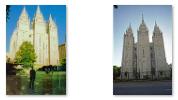

 |
July 19, 1997: Hiking Around Jenny Lake in Grand Teton National Park |
 |
Return to the Index for Our Yellowstone Trip |
Today, our last day here in the Yellowstone area, we're going to visit the museum we drove by yesterday, walk around Jackson, Wyoming and drive to Salt Lake City, where we will look around for a while before heading to the airport for our flight home.
The National Museum of Wildlife Art
|
We had been at the museum yesterday afternoon after our hike to Inspiration Point in Grand Teton National Park, but we got there after the museum had closed for the day. So we are back again today to have a look inside.
In 1984, 10 founding trustees chose Jackson Hole, Wyoming, with its abundant wildlife, beautiful mountain setting, and high tourism, as a unique and appropriate setting for an art museum focused on images of wildlife. The original museum opened as Wildlife of the American West Art Museum on May 16, 1987 on Jackson’s Town Square.
By 1992, the National Museum of Wildlife Art had outgrown its three-gallery, 5,000 square-foot storefront. A capital campaign was launched to raise money for a new facility and an endowment.
In September 1994, the Museum opened its new facility, a 51,000 square-foot state-of-the-art building that allowed for expanded exhibition space, museum programs, and educational programming; it was located about six miles north of Jackson on the highway to Grand Teton National Park and Yellowstone National Park.
|
Representing the culmination of a lifetime of study and collection of wildlife art by Joffa and Bill Kerr who, over a 30-year period, developed a collection of wildlife art unsurpassed in the United States, the Museum is currently comprised of 14 distinctive galleries, Sculpture Trail, Museum Shop, Rising Sage Café, Children’s Discovery Gallery, Library, and administrative space (although not all of these rooms and facilities were in place at the time of our visit).
The Museum’s permanent collection of over 5,000 cataloged items includes paintings, sculpture, and works on paper by over 100 distinguished artists ranging from early American Tribes through contemporary masters. The Museum’s permanent and temporary exhibitions are augmented with innovative educational and scholarly programs emphasizing art appreciation, art history, natural science, creative writing, and American history.
The Museum has become an important educational center and meeting place for the Jackson Hole region. In 1994, the National Museum of Wildlife Art received the Wyoming Humanities Award for exemplary efforts in fostering the humanities in Wyoming. (Eleven years after our visit, the Museum received designation as the “National Museum of Wildlife Art of the United States” by order of Congress.) I don't know how many people visited the museum each year in 1997, but by the second decade of the 21st century, more than 80,000 people a year (10,000 of them children on school-related outings) were visiting the facility.
|
The Museum’s location actually provides a rare opportunity to view wildlife in its natural habitat, not just the artwork that pays tribute to it.
Designed by C.W. Fentress, J.H. Bradburn and Associates of Denver, Colorado and constructed of Idaho Quartzite, the building was inspired by the ruins of Slains Castle in Aberdeenshire, Scotland. The structure blends seamlessly into the native terrain of Jackson, Wyoming, and reflects the area’s natural beauty.
We spent more than an hour inside the museum, looking through the various galleries at the impressive collection of wildlife art. The collection covers various genres including explorer art, sporting art, Romanticism, Realism, Impressionism, and Modernism. The Museum also includes a wide variety of media, such as oil, bronze, stone, acrylic, watercolor, gouache, pastel, pencil, lithography, photography, and charcoal.
|
The artist sculpted bison shedding their winter coats, getting ready for the change of seasons and warmer weather. Kelsey’s style is very expressive, leaving the visible strokes of his fingers on the bronze surface. He eliminates detail, but implies hints of anatomy and muscle structure in his forms.
This piece, and the others that we saw, were incorporated into a Sculpture Trail that opened a decade after our visit. Another cast is located nearby at the Buffalo Bill Center of the West in Cody, Wyoming.
There were two other pieces outside that we photographed. One, entitled "Whitetail Doe Looking Back" is by the sculptor Kenneth Bunn, and you can see it here. The other sculpture has eluded my identification. I cannot locate it in the Museum's online collection inventory, so either I am searching incorrectly or the piece is no longer in the collection. It was an eagle with its wings outstretched, and you can have a look at it here.
In Jackson, Wyoming
|
George Washington Memorial Park is located at the center of Jackson, Wyoming. More generally known as "Town Square", the park is notable for its elk-antler arches at each corner of the park, collected from the nearby National Elk Refuge by Boy Scouts and periodically rebuilt. The square originally existed as an open space in the center of town that was made into a park in 1934.
The Town Square originated as an open space in the middle of Jackson where no buildings had yet been built, surrounded by more developed blocks in the sparsely settled street grid of the town. The area was used as a commons area by people and occasionally as a thoroughfare for migrating elk.
In 1917 the town graded the surrounding street and obtained title to most of the land, using excess material from the grading to even out depressions in the square's surface. In 1924 the town undertook further improvements to the area, now called "the little park in the center of the town." The initiative yielded further grading. A few trees were planted, but were then indifferently maintained.
With the two hundredth anniversary of the birth of George Washington approaching in 1932, the state of Wyoming cooperated with Congress to prepare memorials throughout the state. The Wyoming plan was to establish a George Washington Memorial Park in as many communities as possible. The Town Square was designated the George Washington Memorial Park for Jackson in 1932. The organizing committee raised over $150 (not $150,000, just $150) in public donations to landscape the park.
|
In short order the Square became the center of Jackson's civic life. A memorial to John Colter was placed in the center of the park in 1939. John Colter (c. 1774 – 1813) was a member of the Lewis and Clark Expedition (1804–1806). Though party to one of the more famous expeditions in history, Colter is best remembered for explorations he made during the winter of 1807–1808, when he became the first known person of European descent to enter the region now known as Yellowstone National Park, and to see the Teton Mountain Range. Colter spent months alone in the wilderness, and is widely considered to be the first "mountain man".
In 1953 the local Rotary Club built an arch of elk antlers at the southwest corner of the park. Arches were erected at the remaining corners in 1966, 1967 and 1969. The antlers were collected by students, scouts and others in the Elk Refuge north of Jackson.
|
Behind me, diagonally across the intersection, is the main store of Coldwater Creek- the catalog company. Fred likes their merchandise very well, so we spent some time shopping there. Down the street and up the hillsides you can see some of the ski runs of Jackson Hole. Unlike most tourist destinations, Jackson has most of its visitors in the winter (not counting those just passing through for the two major national parks).
Anyway, we had an interesting time walking around Jackson and looking into the shops and having a bit of lunch. Jackson is really picturesque, and we could easily have spend a good deal more time here. But we didn’t have much, and continued our drive through town to the road to Rexburg.
|
At the crest of the Teton Range, we stopped to take a look back towards Jackson, bookending the trip with the same views we’d seen coming into the area for the first time. Two of these amazing views are below:
 |
 |
Temple Square in Salt Lake City
 |
We parked a short distance away from the square, and we walked a couple of blocks to come to it and have a look around. In 1847, when Mormon pioneers arrived in the Salt Lake Valley, LDS Church president Brigham Young selected a plot of the desert ground and proclaimed, "Here we will build a temple to our God." When the city was surveyed, the block enclosing that location was designated for the temple, and became known as Temple Square. Temple Square is surrounded by a 15-foot wall that was built shortly after the block was so designated.
|
As the church has grown, its headquarters have expanded into the surrounding area. In 1917, an administration building was built on the block east of the temple and in 1972, the twenty-eight story LDS Church Office Building, which was, for many years, the tallest building in the state of Utah. In front of the office tower is a reflecting pool.
Of course, the most recognizable building is the Salt Lake Temple, and we took our first picture of it from its south side and the fountain there. You can see that picture at left.
Many people, including me, mistake this particular building, and think it is the Mormon Tabernacle (the home of the choir). As you can see from the aerial view, however, the Mormon Tabernacle is actually the elliptical-shaped building southwest of the Temple. At 253,015 square feet, the Salt Lake Temple is LDS Church's largest. Dedicated in 1893, it is the sixth temple completed by the church, requiring 40 years to complete, and the fourth temple built since the Mormon exodus from Nauvoo, Illinois, in 1846.
|
The official name of the Salt Lake Temple is also unique. In 1999, as the building of LDS temples accelerated, the church announced a formal naming convention for all existing and future temples. For temples located in the United States and Canada, the name of the temple is generally the city or town in which the temple is located, followed by the name of the applicable state or province (with no comma). For temples outside of the U.S. and Canada, the name of the temple is generally the city name followed by the name of the country. However, for reasons on which the church did not elaborate, the Salt Lake Temple was made an exception to the new guidelines and was not renamed the "Salt Lake City Utah Temple".
The temple also includes some elements thought to evoke Solomon's Temple at Jerusalem; it is oriented towards that city and has a baptismal font that mirrors the biblical description of the one in Solomon's Temple. At the east end of the building, the height of the center pinnacle to the base of the angel Moroni is 210 feet, or 120 cubits, making this Temple 20 cubits taller than the Temple of Solomon. Click on the thumbnail images below to see a couple more of our pictures of the Temple:
 |
In addition to the pictures of the temple above, Fred got out his panoramic camera to see how the structure would look in vertical panorama. It satisfied him, so we each took a vertical panorama of the other, and these I have put in the scrollable windows below:
|
|
|
The temple is located in downtown Salt Lake City, with several mountain peaks close by. Nearby, a shallow stream, City Creek, splits and flows both to the west and to the south, flowing into the Jordan River (which was, of course, named by the Mormons after their arrival).
|
The last stop we made was at the visitor center that sits north of the Mormon Tabernacle building. We had a short tour there with a guide.
We enjoyed our time at Temple Square, but at last had to drive on out to the airport to catch our flight home to Dallas. This was an extremely enjoyable trip, where we broke entirely new ground. Many of our trips involve returning to the same area to see different things, but this was an entirely new experience for us. It will rank as one of the best trips we’ve taken so far.
You can use the links below to continue to another photo album page for our Yellowstone Trip or to return to the Index Page for this trip so that you can go elsewhere in the photo album.
 |
July 19, 1997: Hiking Around Jenny Lake in Grand Teton National Park |
 |
Return to the Index for Our Yellowstone Trip |